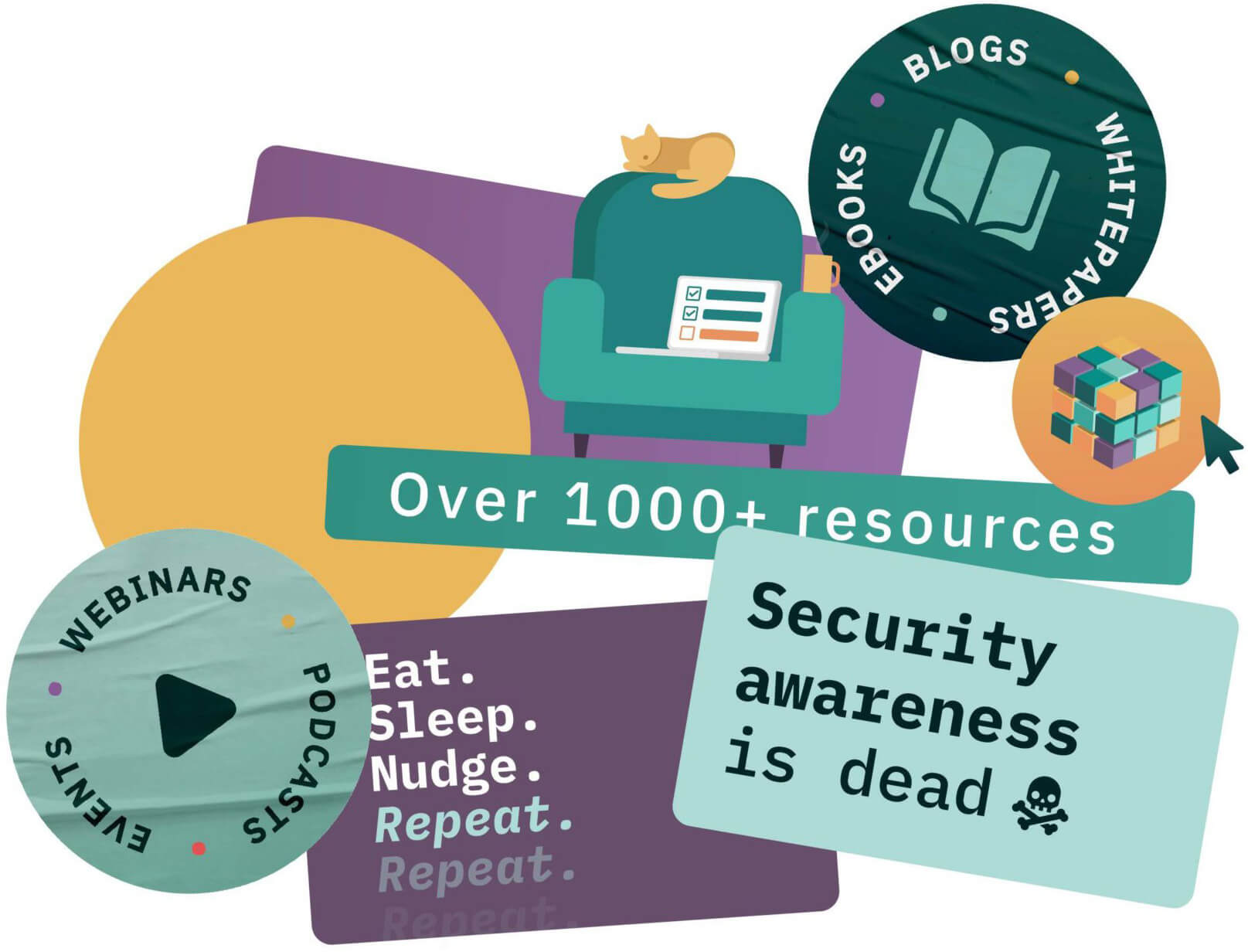A guide to our tone of voice
Before we get started, a warning: You’ll probably find this guide hard to read. That’s because you’re human. Humans find everything hard to read. Books, product guides, blogs, and flat-pack furniture manuals (top of the list). They’re all the same. CybSafe copy acknowledges this. In response, our copy follows some rules. The rules make our copy easier to read. The rules are listed in part 1 below. To write like CybSafe, follow them. However, the rules will only get you so far. To really write like CybSafe, you’ll need to convey our tone. You’ll need to favour certain words. You’ll need to add rhythm to your writing. You’ll need to make judgement calls. Occasionally, you’ll need to break reading-ease rules. Tips for conveying CybSafe’s tone are covered in part 2. But let’s start with part 1 – making your writing easy to read.
Part 1: How to make your writing easy to read
Use sentence case for all titles and subtitles
Sentence case makes our titles and subtitles easy to read. We use sentence casing everywhere. It makes us look professional and aligned. When writing titles and subtitles, only capitalise the following words:
- The first word of the title or heading
- The first word of a subtitle
- The first word after a colon, em dash, or end punctuation in a heading
- Nouns followed by numerals or letters
- Proper nouns (such as the names of people or groups)
Use short sentences
Short sentences are easy to follow. Keep sentences short. Favour full stops over commas. It’s simple stuff.
Use short paragraphs
Short paragraphs are also easy to follow. Plus, short paragraphs inject your copy with white space. When readers see your copy as a whole, short paragraphs ensure they’re not facing an impenetrable wall. Instead, they see digestible segments.
Use simple words
Simple words are easy to take in. Avoid poetic language. Keep syllables low. Favour “use” over “utilise”. Favour “start” over “commence”.
Use subheadings
Reading tests show people don’t read copy in the way it’s written or reviewed. They don’t start from sentence one then continue sequentially. Instead, they see everything at once and scan it all over. Subheadings help with the scanning. They’re signals. Used wisely, they can deliver the message without requiring any further reading. Subheading should summarise what comes in the paragraph. The subheadings in this guide are a good example.
Avoid jargon
Jargon may puzzle some readers. Make things simple. Use plain English to keep people engaged.
Use conjunctions
Conjunctions are connecting words like ”and” and “but”. Conjunctions keep people reading. Use them, and don’t be afraid to use them at the start of your sentences and paragraphs.
Use the active voice
Pen your subjects as active rather than passive. “The students were reading” is active, as the students were getting something done. “The book was read” is passive. The students played a passive role in the reading. They’re not even mentioned in the sentence. If a phrase makes sense after adding “by monkeys” to the end of it, then it‘s passive. (Credit for this analogy goes to Monzo!) 🐒
Avoid clichés
Clichés are tired and unexciting. The phrase “it’s like swimming through treacle” now fails to paint the picture of someone swimming through treacle. It’s unoriginal and unremarkable. The substitute “it’s like wading through hummus” still indicates a struggle, but it’s novel. It paints a picture. Thinking readers may even “feel” the struggle. Avoid clichés to keep people hooked.
Avoid adverbs
Adverbs modify or qualify things. She ran quickly. He said forcefully. With skill, you can eliminate them. She sprinted. He spat. Removing adverbs reduces word count. It also invigorates copy.
Use Hemingway
Hemingway highlights complex sentences and words. It also highlights adverbs and passive phrases. Use Hemingway to weed out complex sentences, words, adverbs and passive phrases. Hemingway helps improve reading ease.
Part 2: How to “sound” like CybSafe
2.1 Choose your tone
As nice as it would be, CybSafe’s tone is not uniform. Context matters. Our tone varies depending on who we’re writing for, what we’re writing about and where we’re writing it. If this sounds odd, consider how you might talk to a child. Now consider how you might talk to your boss. The different audiences demand different tones. Now consider writing a tweet. Now consider writing a contract. CybSafe’s tone should and does vary. So choose your tone. That said, our personality is static. At CybSafe, we’re (amongst other things) human, positive, fun, bold and intelligent. Also, we don’t sit on the fence! We’re not afraid to say it like it is. Try sprinkling your copy with each as appropriate.
2.2 How to sound human
Write as you’d speak
In everyday conversation, humans favour simple language. We use the active voice. We avoid jargon. Read your copy aloud. If it sounds off, edit.
Use short sentences… but mix things up
Short sentences are easy to read. That’s why we use them. They’re recommended. But don’t go too far. You’ll sound robotic. When writing CybSafe copy, the occasional comma isn’t really a problem. And, actually, human conversations are full of “unnecessary” words. So favour short sentences. But mix things up. We don’t want to put our readers to sleep.
Avoid jargon… but write for your audience
Human conversation builds rapport. We want to do the same thing with our copy. We want to show our readers we know their world. Jargon can help make that happen. Don’t go overboard. But when writing for CISOs, the occasional reference to something like phishing is fine. Always consider your reader. CISOs know what phishing is.
Use the active voice… unless using the passive voice makes sense
Look at the following active sentence. Historically, CISOs have made some big security mistakes. The above sentence is active. To CISOs, it’s also offensive. In human speech, we’re courteous. We use the passive voice to lessen offence. Here’s the passive equivalent of the above. Historically, some big security mistakes have been made. The CISOs’ actions have been removed. We’re not pointing fingers at CISOs. We’re not blaming anyone. Need another example of a passive sentence that makes sense? Here you go: The CISOs’ actions have been removed. That’s a passive sentence. The active equivalent is “I’ve removed the CISOs’ actions.” It’s arrogant. It also presumes the reader knows who wrote this document. They might not. So the passive voice makes sense. Favour the active voice. But be human. Sometimes, the passive voice makes sense.
Avoid adverbs… but make your message clear
People use weak passwords. That’s a true statement. It’s also ambiguous. Do people use weak passwords all the time? Or do people only use weak passwords some of the time. People sometimes use weak passwords. This introduces an adverb (“sometimes”). But it clarifies things. You could argue “people favour weak passwords” is an adverb-less improvement. But is it? Do people really favour weak passwords? Probably not. Adverbs can clarify meaning. We use them in human speech. So there’s no blanket ban in CybSafe copy. This document includes adverbs throughout.
Use contractions
Replace “would not” with “wouldn’t”. Replace “she will” with “she’ll”. Replace “they are” with “they’re”. You’d do it when speaking. Do the same when writing. There’s one exception to this. If you’re using the same contraction twice in a short span, consider breaking things out, so you are not repeating contractions.
2.3 How to sound positive
Use positive language… but don’t go overboard
Great. Awesome. Incredible stuff. Used sparingly, positive words can create positivity. But when overused, they lose their power. When everything is awesome, awesome is average.
Exclaim!
When people get excited, their tone changes. Their faces light up. They’re wide-eyed. You can convey this in copy with the exclamation mark. Great. Awesome! Incredible stuff. Again, take care here. We’re positive. But not intense. The odd exclamation mark is fine. But, when everything is exciting, exciting is average.
2.4 How to sound fun
Exclaim!
When people get excited, their tone changes. And people get excited when delivering jokes. You can convey jokes in copy with the exclamation mark. The sentence “Trojans don’t harbour bloodthirsty Ancient Greeks.” conveys no emotion. It forces readers to deduce the joke. The sentence “Trojans don’t harbour bloodthirsty Ancient Greeks!” comes with a signal. The exclamation adds some fun.
Use emojis
Emojis clarify meaning. But, even better, research proves they make for more effective communication. 😃 The great news is you don’t even need to stick to faces. Objects do the same thing! 🎉 Use emojis to reinforce words. Not to replace them. Feel free to use them to make your copy fun. But be careful not to overuse them. One emoji every few paragraphs is about right. It probably goes without saying. Don’t use emojis in formal copy, like proposals and contracts. That would be inappropriate. 😬
Elaborate
Condensing messages implies they’re boring. Elaboration suggests the opposite. You can reiterate. You can give examples. In places, you can say the exact same thing more than once. Yes, the exact same thing… more than once! You’re having fun. So what’s the rush?
Add filler
Filler is… er… Well, not many people use it to be perfectly honest! Filler is the little words. The unnecessary pauses. Think “um”, “er”, “ah” and “OK”. Use them. Because… well because they’re playful. Filler is fun.
Specify
CybSafe copy specifies for clarity. And because we’re fun. OK, the above paragraph is specific. But it could be more specific: CybSafe copy specifies for clarity. And because we’re a little bit fun. Notice the direction of specificity makes very little difference: CybSafe copy specifies for clarity. And because we’re really quite fun. The additional specificity is a form or elaboration. It elongates copy. Who cares? It’s fun!
Relax
Ditch the formalities. Not always. But, in places, feel free to loosen your tie. “Yes” can be “we get you”. “No” can be “Negative”.
Expressions
Sigh. Moan. Groan. Nod. Yawn. Inhale. Gulp. Squirm. You won’t find expressions in formal copy. Fun copy, however, rarely holds back.
Empathise
We know, we know. Conveying empathy isn’t easy. So try this simple trick: Go ahead and note what you think your reader is feeling. Then tell your reader you understand. Confused? That’s understandable! You might find adapting this paragraph helps.
Be honest
Step outside of work mode. Passwords are hard to remember! Security is sometimes confusing! Don’t disagree with your reader. Charm them. Here’s a good example: “Have I been pwned?” is internet slang for “have I been owned?”… which is internet slang for “have I been defeated?”. So much slang! Well, security is cool… 😎
2.5 How to sound intelligent
Use simple words… but vary vocab
You can add varied vocabulary to your copy. Or you can weave it in. You can lace your copy. You can inject it. You can sprinkle your copy with varied vocab. You can pepper it. Or dust it. They’re simple words – but they’re unusual. They’re metaphorical. They paint pictures and add excitement. They make copy sound intelligent.
Use short sentences… but beware of fragments
“Fragmented” sentences are incomplete sentences. They either omit a subject or a verb. They’re often powerful. Just look at the fragmented sentences in the paragraph below (they’re italicised). The consequences of poor security can be extreme. Data loss. Theft. Even death. The fragmented sentences are cutting. But they’re also grammatically incorrect. Only use fragments knowingly. Inadvertent fragments undermine our intelligence.
Ask questions
Intelligent people guide others. They usher them along. How? Questions help. Questions let you posit answers. They also echo your reader’s thoughts. They keep your reader following along. Questions keep your copy engaging.
Take care with rhetoric
When you ask rhetorical questions, people can disagree. This undermines our intelligence. Here’s an example. Why not use rhetorical questions in your copy? There’s a good reason why not: they undermine our intelligence. When penning rhetorical questions, make sure there’s no room for disagreement.
Avoid ending sentences with prepositions
At. In. Of. To. At best, ending sentences with prepositions is informal. At worst, it’s dumb. Consider, Which journal was your article published in? You won’t see it much in writing. In which journal was your article published? is an intelligent alternative.
Use Hemingway… but overrule
Hemingway can be a bit like a game. It tells you what you need to fix. You fix it. You score a point. This makes it tempting to do everything Hemingway suggests. But remember: Hemingway is an algorithm. It has limitations. It knows what you’re doing. But it’s not sure why. It’s not sure why you’re using adverbs. It’s not sure why you’re using complex language. Don’t be scared to overrule Hemingway. Remember it’s an algorithm. Tone aside, the algorithm sometimes gets things wrong.
2.6 How to sound bold
Be direct
Get to the point. Use one word instead of two. Make your meaning clear. I think we should probably do this. That’s indecisive. We should do this. That’s more like it.
Avoid contractions
That wouldn’t work. That would not work. “Wouldn’t” is casual. “Would not” carries gravitas. Replace the odd contraction to make a phrase sound bold.
Emphasise
Here’s an example: We can be bold even when opportunities are scarce. We can be bold even when opportunities are scarce. The italics signal emphasis. They’re the equivalent of leaning in and delivering a line with punch. When used correctly, emphasis ensures we sound bold.
Write in the present tense
Humans can prevent data breaches. Humans prevent data breaches. The former includes a caveat. There’s doubt in the sentence. The latter, present-tense sentence is assertive. It’s inarguable. It’s bold. Favour the present tense.
Cast heroes
Heroes are bold. You can include them in your copy. CybSafe can be a hero. We reduce cyber risk. But that’s a little arrogant. If possible, our reader should be the hero. With CybSafe, you reduce your cyber risk. With CybSafe, you help your family.
Be visionary
This will often manifest itself in conclusions. It’s nurtured through rhythm. As you’re writing, picture great leaders and famous speeches. Tune into triumphant music playing in the background. Let it build. And build. Let it build even more. In your final few sentences, let the music blare. Say something visionary. Allow your syllables to rise! Then step back… Let things die down… Make your closing remark. Repeat the remark. It creates a visionary tone.
2.7 Avoid writing these things
Employees
Employees are people. They’re not inanimate, unthinking objects. Humanise. As opposed to referring to ‘employees’, refer to ‘people’. This makes our message clear.
Users
Only two groups of people call their customers “users”. Security professionals and drug dealers. Try to humanise where you can: as above. 👌 Overall, use inclusive language. Respect diversity. Avoid words and terms that reflect stereotyped or prejudiced views of certain groups or people. Some words are okay to use in some context, but not in others. So be mindful! 🧠
People are the weakest link (actually, never write this!)
This reinforces a questionable school of thought: it implies people are a vulnerability to be patched. They’re not. People are a defence. Although it’s unreported, people prevent breaches. We want to highlight this. As opposed to declaring people a weak link, highlight their positive security role. People are our strongest defence.
People cause breaches
Criminals cause breaches. People prevent them.
(When referring to CybSafe) “Training”
CybSafe is not training. It’s a platform. It’s software. CybSafe manages human cyber risk.
2.8 Use sound judgement
As a parting note, the advice in this document is generic. In places, it’s conflicting. You might decide to go against it. If there’s a good reason to do so, go for it. Writing isn’t an exact science. So use your judgement. And have fun along the way.
Part 3: Bonus step: Read
CybSafe copy
The more you read, the better your writing will be. Reading CybSafe copy will show you what you’re aiming for. Read CybSafe course content. Read CybSafe marketing and internal communications, too. You don’t need to stop there. There are dozens of good copywriting resources available. Below are a few to start with.
Some good books on writing copy
- How to write better copy by Steve Harrison
- The copy book by D&AD
- Write to sell by Andy Maslen
- Scientific advertising by Claude Hopkins
- Common sense direct and digital marketing by Drayton Bird
- Tested advertising methods by John Caples
Some good books on writing in general
- On writing: A memoir of the craft by Stephen King
- Politics and the English language by George Orwell
- Into the woods: How stories work and why we tell them by John Yorke
- The reader’s brain by Yellowlees Douglas
- The elements of eloquence: How to turn the perfect English phrase by Mark Forsyth







